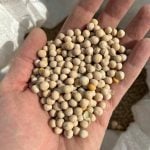In Canada, soybean production has been quite a success story. Where at one time soybean production was concentrated in the extreme southwest of Ontario, now it is an important part of cropping plans in an ever-expanding area. In 2016, however, there are many management challenges ahead for Canadian soybean producers.
Change is our only constant, and as 2016 comes into full view, it appears that changes in the Canadian soybean complex will certainly test our management skills this year.
Our soybean acreage is increasingly shifting to Western Canada even though Ontario is still the dominant player with 2.9 million acres planted in 2015. Manitoba had the second-largest provincial soybean acreage in 2015 at 1.385 million acres, which is on a more or less steady up-trend.
Read Also

Producers aren’t panicking over tariffs and trade threats
The influence of tariff and trade uncertainity on farm business decisions.
Statistics Canada for the first time in 2013 actually recorded Saskatchewan soybean acres at 170,000. This past year, Saskatchewan farmers planted 270,000 acres, and clearly, there is a huge potential in Western Canada that continues to be a focus within the industry. In Quebec in 2015, meanwhile, 778,400 soybeans acres were grown with Prince Edward Island adding another 54,000 acres.
Of course it is one thing to grow soybeans, and it is another thing to market them. There are many advantages and disadvantages to growing and marketing soybeans across Canadian soybean country. For instance, in Ontario there is a well-established soybean infrastructure with both crushing facilities and export terminals on the water. Quebec is closer to salt water than Ontario and this gives it a further advantage. In Prince Edward Island, shipping costs ($60/tonne) to the nearest crusher in Quebec negatively affect the basis, while shipping to the Halifax port is much more preferable.
In Western Canada, however, basis levels are very low for soybeans, just as they are for other grains, since they must be either exported out with only a small percentage being crushed.
The diversity that we have in Canadian soybean country certainly is reflected in the soybean basis levels at which soybeans are moved, bought or sold. Depending on where you find yourself within Canada, basis calculations tell their own local and regional story.
With that as a backdrop, marketing our soybeans is never easy. Our provincial cash markets are different from each other. However, soybean prices are always based on the futures market plus or minus a certain basis level.
Those futures prices for soybeans are determined at the Chicago Mercantile exchange and in 2015 these reached new lows compared to the last seven years. At the end of December 2015, March soybean futures were hovering in the $8.70 area. At the same time in 2014 and 2013, the nearby futures month was $10.47 per bushel and $13.27 respectively. It’s been a long tortuous retreat in the soybean futures price.
How did we get here? The last several growing seasons in the United States and in South America have been benign. For instance, in 2015 on 88.4 million acres of corn, the U.S. yielded 169.3 bushels per acre. This is impressive, but on 85.1 million acres of soybeans, the U.S. also produced 48.1 bushels per acre (Dec. 15 USDA).
Even though demand has been impressive worldwide, the soybean supply has kept up with that demand. This has been accentuated in 2015 and early 2016 with the general bearishness in commodities worldwide.
The low soybean price environment is also a function of the continuing production coming out of South America, and out of Brazil in particular. For the 2015-16 production year, the USDA is predicting a 100-MMT crop of soybeans from Brazil, another record. Argentina is set to produce 57 MMT of soybeans. This production along with other production in South America continues to weigh on the soybean complex into 2016.
What lies ahead on the futures price front, and what is it going to take for soybean prices to recover? Or is it a question of soybean prices continuing on a road to lower price levels not seen in quite some time?
By early 2016, the Brazilian and Argen-tinian soybean crops were growing well. However, hot, dry weather and sporadic precipitation has been impacting the Brazilian crop in the large producing state of Mato Grosso. The impact of this may affect the Brazilian supply. Weather will be key in this growing region and may be reflected in market prices early in 2016.
The bottom line, however, is that if we are going to move out of this low-price environment, we need to get some type of bullish fresh news. In fact, it might take a “black swan” event to get the market moving.
As it is, if soybean production areas in the United States and South America continue to give average to above-average soybean crops, there really is no reason to get excited about soybean futures price values. Under that scenario, it is likely that prices remain in the $8 and $9 range.
However, we all know that agricultural prices are cyclical and there will be some type of production calamity somewhere to change the scenario. Daily market intelligence will always remain key; just as risk management never grows old.
When it comes to soybean prices, the big difference for Canadian producers is the value of the Canadian dollar. With the worldwide meltdown in commodity prices, accentuated by the drop in oil and the appreciation in the American dollar, our Canadian dollar has fallen and not substantially recovered.
This has resulted in Canadian “price optics” completely different than in the United States. For instance, even at such low soybean futures values cash prices ($8.70) in SW Ontario the mid-winter cash price for old-crop soybeans had a positive basis of $2.90, giving a price of C$11.50 per bushel. The new crop (2016) also had a positive basis value of C$2.60. This is different from American farmers who face “price optics” in old-crop soybean prices of US$7-$8 per bushel.
These Canadian “price optics” are important because the fluctuating value of the Canadian dollar adds another management layer to our soybean marketing. We, as soybean farmers, must anticipate Canadian dollar fluctuations along with soybean futures price values. For instance, on Jan. 1, 2014 the Canadian dollar was at .9438, the futures price of soybeans was $13.47 with a negative cash basis of -.35. On Jan. 1, 2015, the nearby futures prices were $10.47 with a positive basis of $1.56 at a .8660 Canadian dollar. Heading through 2016, any soybean futures rally will accentuate cash prices especially at these low Canadian dollar levels.
Into 2016, as well, marketing on any futures price rallies will surely be key. China continues to have a voracious appetite for soybeans projected to import 80.5 MMT in the 2015-16 crop year. This represents a dynamic demand picture even at a time of overabundant supplies. The USDA is predicting 465 million bushels for U.S. soybean-ending stocks this year, but has always grossly overestimated that in the past. 2016 should be no different.
Even without a production calamity in American fields, those ending stocks will decrease. Of course, if there is severe bad weather in a major production zone or a black swan event, inventories everywhere will drop significantly.
So, we hope to see prices rise in 2016, but that won’t necessarily be the reality. If production levels remain the same around the world, a sideways to down pattern in futures price levels may persist. In fact, the argument can be made that this may be likely. At the end of the day, market-impacting weather will have the last call on how large and impactful soybean supply will be in 2016.
Will our American friends plant over 85.1 million acres next year, even at a time of low prices? U.S. planted acres will make a difference in 2016. Within this tangled web of market factors the value of the Canadian dollar will continue to challenge our cash soybean price management. Will the rains be timely in Brazil and then in the United States? The road ahead in 2016 for Canadian soybean producers is never the same.
The challenge for Canadian soybean producers will be to take the measure of all these different market factors.
This article was originally published as Looking for a black swan in the February 2016 issue of the Soybean Guide















